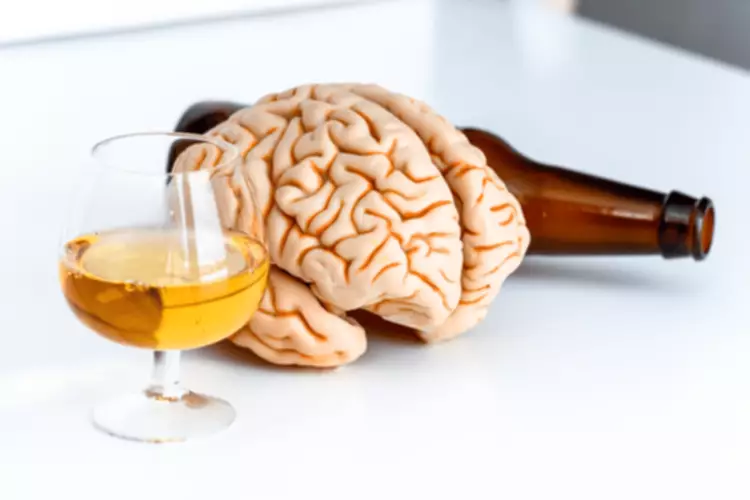
However, in most cases, when referring to IMB, one usually refers to the populations of bacteria that have colonized our large intestine. Gut dysbiosis, which may result in an overgrowth of Gram-negative bacteria [38], can be yielded by the direct toxicity of the alcohol or by indirect mechanisms triggered by alcohol such as the alteration of gut motility [43], the gastric acid output [44], the bile-acid metabolism [45] and an increase in fecal pH [46]. In 2016, the harmful use of alcohol resulted in some 3 million deaths (5.3% of all deaths) worldwide and 132.6 million disability-adjusted life years (DALYs), i.e., 5.1% of all DALYs in that year. Among men in 2016, an estimated 2.3 million deaths and 106.5 million DALYs were attributable to the consumption of alcohol.

Approaches for Resolving Alcohol-Induced Liver Inflammation
This review proposes that HMGB1-TLR pro-inflammatory signaling induces epigenetic gene silencing and enhancing mechanisms that alter glial and neuronal transcriptomes, changing cellular phenotypes. Evidence supports that epigenetic gene-regulating mechanisms such as histone methylation are involved in causing microglial and astrocyte sensitization or priming that increases pro-inflammatory gene expression, including TLR and other genes. Further, studies found that cholinergic neurons respond to HMGB1-TLR signaling with increases in REST that silence ChAT and other cholinergic genes, changing neuronal phenotypes (i.e., reducing cholinergic neurotransmission). These epigenetic shifts in cellular phenotype are proposed to contribute to altered networks that show progressive involvement of brain regions, consistent with the progressive changes across binge intoxication, negative affect, and cognitive dysfunction components of AUD (Figure 3). Inhibitors of epigenetic signals, like anti-inflammatory treatments, can reverse and prevent binge drinking adaptations across glia and neurons, as well as behavioral changes in alcohol drinking, anxiety, and cognition.

The Adaptive Immune Response

Alcohol modifies the intestinal microbiota, pH and permeability of the intestine, causing an increased entry of endotoxins into our CNS and brain, leading to neuroinflammatory processes. Several studies have demonstrated the dose-dependent effect that alcohol has on preventing both monocytes and macrophages from binding to the bacterial cell wall component lipopolysaccharide (LPS). Within the GI tract, alcohol exposure can also alter the number and abundance of microorganisms present within the microbiome, all of which play an important role in normal GI function. In addition to its adverse effects on GI functioning, the impact of alcohol on the GI microbiome can also alter the maturation and functions of the immune system.
Characterization of fecal microbial communities in patients with liver cirrhosis
For instance, diet is considered as one of the many drivers in shaping the gut microbiota across the lifetime. By contrast, alcohol is one of the many factors that disrupt the proper functioning of the gut, leading to a disruption of the intestinal barrier integrity that increases the permeability of the mucosa, with the final result of a disrupted mucosal immunity. This damage to the permeability of the intestinal membrane allows bacteria and their components to enter the blood does alcohol weaken your immune system tissue, reaching other organs such as the liver or the brain. Although chronic heavy drinking has harmful effects on the immune system cells at the systemic level, this review focuses on the effect produced on gut, brain and liver, because of their significance in the link between alcohol consumption, gut microbiota and the immune system. Following chronical excessive alcohol intake, the intestinal barrier becomes “leaky” by altered tight junctions of epithelial cells.
Liver Cell Types and Their Roles in ALD
As described above for thymopoiesis, the offspring of pregnant mice that from gestational day 1 to day 18 consumed a liquid diet in which 25 percent of calories were derived from ethanol exhibited decreased numbers of both immature and mature B cells in the spleens directly after birth. Moreover, these B-cell subpopulations did not recover to normal levels until 3 to 4 weeks of life (Moscatello et al. 1999; Wolcott et al. 1995). Other studies were conducted using a precursor cell type called oligoclonal-neonatal-progenitor (ONP) cells, which in vitro can differentiate either into B lymphocytes or into other white and red blood cells (i.e., myeloid cells), depending on the cytokines to which they are exposed.
Chronic alcohol consumption reduces B-cell numbers, decreases antigen-specific antibody responses, increases the production of auto-antibodies, and interferes with B-cell development and maturation. In addition to pneumonia, alcohol consumption has been linked to pulmonary diseases, including tuberculosis, https://ecosoberhouse.com/ respiratory syncytial virus, and ARDS. Alcohol disrupts ciliary function in the upper airways, impairs the function of immune cells (i.e., alveolar macrophages and neutrophils), and weakens the barrier function of the epithelia in the lower airways (see the article by Simet and Sisson).

Alcohol and the Innate Immune Response
Alcohol and HIV Effects on the Immune System
- Normal immune function hinges on bidirectional communication of immune cells with nonimmune cells at the local level, as well as crosstalk between the brain and the periphery.
- A study conducted in 2015 showed that blocking TLR4 function most of the neuroinflammatory effects produced by ethanol were diminished [104].
- Coupled with the observations of Mandrekar and colleagues (2011) on MCP-1, these findings also establish a link between innate immune activity and steatosis.
- Alcohol’s widespread effects on immune function also are underscored in the article by Gauthier, which examines how in utero alcohol exposure interferes with the developing immune system in the fetus.
- In fact, alcohol use has been shown to increase the susceptibility of drinkers to both bacterial and viral infections, as well as advance the progression of several chronic viral infections, including human immunodeficiency virus (HIV) and hepatitis C.
